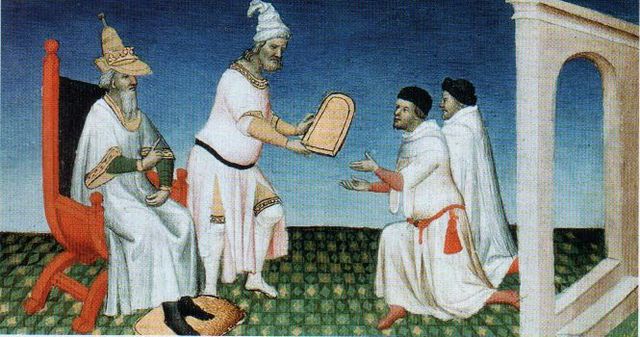Paitsza of Uzbek-khan against the background of Sarai-Batu

The paizza of Uzbek Khan is unique, it was made from 1313 to 1341 during his reign. It is one of the five most famous Golden Horde paizzas containing the names of khans of the Dzhuchid dynasty in inscriptions.
The paitsza was discovered and bought by Russian collector P. I. Shchukin at the Nizhny Novgorod Fair, and was originally kept in his private museum. Currently it is kept in the State Historical Museum, Moscow. Exposition of the Main Building, Room 13.

Paitsza was issued by Mongol rulers to different persons as a symbol of special powers.

On the front side of the paizza of Uzbek Khan is engraved the image of the sun in the form of an eight-lobed rosette, and on the reverse side is the moon in the form of a small circle.
The paitsza of Uzbek Khan is a silver plate 28.2 x 8.8 cm with a hole for a cord. The following text is engraved in gold ligature on the plate in Mongolian in Uighur script:
Möngke Tenggeri-yin küčün-dür
Yeke suu suu zali-yi irgegundür Osbeg-un zarlig:
Ken ulü bisirekü, kümün aldaqu, ükükü
————————————
By the power of the eternal sky,
by the great will of Khan Uzbek:
Whoever opposes, does not submit, that person must die.
About Uzbek-khan
Uzbek Khan was born on March 10, 1283 in the Golden Horde, died on April 7, 1341. He ruled the Golden Horde since 1313. Wives: Bayalun and Taidula. Had seven children.
In 1321, Uzbek Khan accepted Islam and began to introduce Islam in the multicultural Golden Horde by sword and blood in order to create a favorable image for his state. Realizing his goal, he put to death a large number of shamans and Buddhist lamas. His reforms provoked a civil war and, according to some historians, it was this division that served as one of the reasons for the fall of the Golden Horde. Although from a cultural point of view there was a Golden Age in the Horde under him.

Sarai-Batu
As noted by the Arab traveler Ibn Battuta, who visited the Horde in 1333-1334, Saray had «13 mosques for the cathedral service; one of them is Shafi’i. In addition, an extremely large number of other mosques. In it [Sarai] live different peoples, such as: Mongols are the real inhabitants of the country and its rulers; some of them are Muslims; Ases, who are Muslims; Kipchaks, Circassians, Russians and Byzantines, who are Christians. Each nation lives in its own section separately.» [SMIZO, vol. 1, p. 306].
According to the Khorezmian historian Munis (1778-1829), during the reign of Uzbek, after the final establishment of Islam in the Golden Horde, the Mongolian word noyon was displaced by the Turkic bek (biy).
Historians G.A. Fedorov-Davydov and V.L. Egorov speak about the illegal seizure of supreme power by Uzbek Khan and directly call him a «usurper». The Kazakh orientalist, historian, philologist V.P. Yudin (1928-1983), interpreting the legendary character of the news from «Genghis-name» Utemish-haji (Khiva narrator of the XVI century) calls Uzbek-khan «false-chingizid».
Uzbek-khan spoke Mongolian and Turkic languages. In the first half of the XIV century among the Chinggisids and Mongolian nomadic nobility of Desht-i Kipchak, the Mongolian language was not yet completely out of use. In this respect, the example of Uzbek Khan is interesting. In the winter of 718/1318-1319, during Uzbek Khan’s campaign to Arran (the area from Derbent to the bank of the Kura River), according to the account of the historian Vassaf, a contemporary of the Golden Horde Khan, the Deshtians captured two Mongols from the army of Hulaguid Abu Said, the Mongol ruler of Iran, and brought them to Uzbek Khan, who personally questioned them in Mongolian about the situation of the Ilkhan commander Emir Chupan. They answered: «Chupan with ten tumen of troops, for ambush, through Karchag came to your rear». Uzbek Khan in Mongolian said to Kutluk-Timur and Isa-Gurgan: «The man we are looking for is in our rear; where shall we go?» It is remarkable that Hulaguid Abu Said (ruled in Iran in 1317-1335), according to the author of «Tarikh-i Sheikh Uways» Abu Bakr al-Kutbi al-Ahari, «knew well Mongolian and Persian writing and wrote well» [Tarikh-i Sheikh Uways]. [Tarikh-i Sheikh Uways, p. 102].
